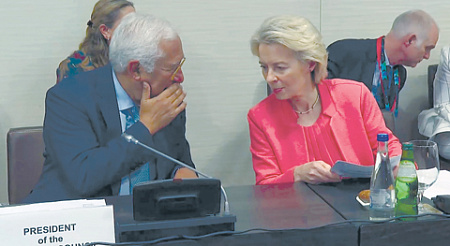
Former President Donald Trump’s proposed peace framework for the Russia-Ukraine conflict is reportedly undergoing substantial revision following fierce opposition from key European allies. What was initially conceived as a pathway to end the continent’s most significant struggle since World War II is now facing a transatlantic tug-of-war, with European leaders deeming several core concessions to Moscow “unacceptable” even as they share the urgency of cessation of hostilities. This emerging divergence highlights a complex geopolitical landscape where the desire for peace collides with fundamental principles of sovereignty and justice.
The gravity of the situation was underscored dramatically when a crucial European Union summit, initially slated to address relations with Africa in Luanda, Angola, saw its agenda entirely upended. European leaders, including the President of the European Council António Costa and European Commission President Ursula von der Leyen, instead found themselves debating the intricacies of a potential Trump-led peace initiative for Ukraine. This sudden pivot, with some commentators drawing unsettling parallels to intractable African conflicts, highlights the profound concern felt across Europe regarding the protracted conflict on its eastern flank, emphasizing the continent’s direct exposure to its consequences.
While a diverse group of EU leaders from Germany, Slovakia, Poland, Spain, the Czech Republic, Croatia, the Netherlands, Italy, Ireland, and Portugal were physically present in Luanda, others, including the High Representative for Foreign Affairs and Security Policy, participated remotely. This arrangement, perhaps accidental, fostered a public perception of rare European unity around the issue, particularly in the absence of more divergent voices like Hungary’s Viktor Orbán or dissenting Baltic state leaders. This consolidated front allowed President Costa to articulate a clear European stance, seemingly signaling a unified position on the contentious peace proposals.
Costa emphasized that any peace resolution for the Russia-Ukraine conflict must involve the EU directly. Crucially, he affirmed that Western support for Ukraine – encompassing financial, military, and diplomatic aid – would continue unabated until a lasting peace is secured. He specifically guaranteed that a decision on substantial financial assistance for Ukraine would be made at the upcoming December EU summit, signaling Europe’s readiness to back Kyiv should pressure arise from other international partners regarding aid, thereby offering a crucial safety net for Ukraine’s continued resilience.
European objections, largely echoing amendments proposed by Germany, France, and the United Kingdom in Geneva, target several contentious aspects of Trump’s plan. A key demand is the removal of a clause that would commit NATO to halt its expansion – a red line for many member states, particularly those bordering Russia. Furthermore, the EU firmly rejects any external restrictions on the size of Ukraine’s armed forces, with President von der Leyen asserting Ukraine’s sovereign right to determine its military strength. Another significant point of contention is Trump’s proposed blanket amnesty for all participants in the conflict; Europe insists that ongoing investigations into alleged war crimes by Russian officials and military personnel will proceed, upholding international legal principles.
Perhaps most critically for the trajectory of future peace, European leaders have voiced strong opposition to any proposal ceding currently uncontested Donbas territories to Russia. Instead, they advocate for territorial exchanges only between Russia and Ukraine, strictly based on the existing line of engagement, and explicitly state that such exchanges should only occur after a stable ceasefire is established. They also counter a stipulation preventing NATO troops from being stationed in Ukraine under any circumstances, suggesting such deployment could be acceptable during peacetime, reflecting a different strategic calculus for post-conflict security.
Another significant point of friction lies in the proposed financing for Ukraine’s reconstruction. Trump’s plan reportedly suggested Ukraine’s recovery be jointly funded by the EU and Russia, with the EU contributing €100 billion from frozen Russian assets and an equal sum from its own budget. An additional €100 billion in Russian assets would reportedly go into a joint Russian-American fund, with a controversial provision granting the United States 50% of the profits from reconstruction investments. The European Commission has unequivocally rejected this proposal, maintaining that frozen Russian assets should serve as “reparations credit” for Ukraine, managed exclusively by Europeans, excluding any American stake – a clear assertion of European financial autonomy and commitment to recompense.
Reports from The Financial Times suggest that Trump’s initial 28-point plan has already been streamlined to 19, indicating a fluid diplomatic landscape. While this aligns with previous statements by Trump acknowledging potential changes to his proposals, the ultimate question remains whether any revised plan will gain acceptance from the Kremlin. Without Moscow’s buy-in, European leaders fear that even the most meticulously crafted peace initiative will amount to little more than diplomatic posturing, leaving the conflict unresolved and its profound humanitarian and geopolitical consequences to linger.
